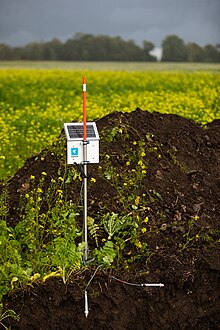
Back Grond Afrikaans Suelo AN تربة Arabic মাটি Assamese Suelu AST Laq'a Aymara Torpaq Azerbaijani توپراق AZB Тупраҡ Bashkir Dėrva BAT-SMG

Soil, also commonly referred to as earth, is a mixture of organic matter, minerals, gases, liquids, and organisms that together support the life of plants and soil organisms. Some scientific definitions distinguish dirt from soil by restricting the former term specifically to displaced soil.

Soil consists of a solid phase of minerals and organic matter (the soil matrix), as well as a porous phase that holds gases (the soil atmosphere) and water (the soil solution).[1][2] Accordingly, soil is a three-state system of solids, liquids, and gases.[3] Soil is a product of several factors: the influence of climate, relief (elevation, orientation, and slope of terrain), organisms, and the soil's parent materials (original minerals) interacting over time.[4] It continually undergoes development by way of numerous physical, chemical and biological processes, which include weathering with associated erosion.[5] Given its complexity and strong internal connectedness, soil ecologists regard soil as an ecosystem.[6]
Most soils have a dry bulk density (density of soil taking into account voids when dry) between 1.1 and 1.6 g/cm3, though the soil particle density is much higher, in the range of 2.6 to 2.7 g/cm3.[7] Little of the soil of planet Earth is older than the Pleistocene and none is older than the Cenozoic,[8] although fossilized soils are preserved from as far back as the Archean.[9]
Collectively the Earth's body of soil is called the pedosphere. The pedosphere interfaces with the lithosphere, the hydrosphere, the atmosphere, and the biosphere.[10] Soil has four important functions:
- as a medium for plant growth
- as a means of water storage, supply, and purification
- as a modifier of Earth's atmosphere
- as a habitat for organisms
All of these functions, in their turn, modify the soil and its properties.
Soil science has two basic branches of study: edaphology and pedology. Edaphology studies the influence of soils on living things.[11] Pedology focuses on the formation, description (morphology), and classification of soils in their natural environment.[12] In engineering terms, soil is included in the broader concept of regolith, which also includes other loose material that lies above the bedrock, as can be found on the Moon and other celestial objects.[13]
- ^ Voroney, R. Paul; Heck, Richard J. (2007). "The soil habitat". In Paul, Eldor A. (ed.). Soil microbiology, ecology and biochemistry (3rd ed.). Amsterdam, the Netherlands: Elsevier. pp. 25–49. doi:10.1016/B978-0-08-047514-1.50006-8. ISBN 978-0-12-546807-7. Archived (PDF) from the original on 10 July 2018. Retrieved 27 March 2022.
- ^ Taylor, Sterling A.; Ashcroft, Gaylen L. (1972). Physical edaphology: the physics of irrigated and nonirrigated soils. San Francisco, California: W.H. Freeman. ISBN 978-0-7167-0818-6.
- ^ McCarthy, David F. (2014). Essentials of soil mechanics and foundations: basic geotechnics (7th ed.). London, United Kingdom: Pearson. ISBN 9781292039398. Archived from the original on 16 October 2022. Retrieved 27 March 2022.
- ^ Gilluly, James; Waters, Aaron Clement; Woodford, Alfred Oswald (1975). Principles of geology (4th ed.). San Francisco, California: W.H. Freeman. ISBN 978-0-7167-0269-6.
- ^ Huggett, Richard John (2011). "What is geomorphology?". Fundamentals of geomorphology. Routledge Fundamentals of Physical Geography Series (3rd ed.). London, United Kingdom: Routledge. pp. 148–150. ISBN 978-0-203-86008-3. Retrieved 16 October 2022.[permanent dead link]
- ^ Ponge, Jean-François (2015). "The soil as an ecosystem". Biology and Fertility of Soils. 51 (6): 645–648. Bibcode:2015BioFS..51..645P. doi:10.1007/s00374-015-1016-1. S2CID 18251180. Retrieved 3 April 2022.
- ^ Yu, Charley; Kamboj, Sunita; Wang, Cheng; Cheng, Jing-Jy (2015). "Data collection handbook to support modeling impacts of radioactive material in soil and building structures" (PDF). Argonne National Laboratory. pp. 13–21. Archived (PDF) from the original on 4 August 2018. Retrieved 3 April 2022.
- ^ Buol, Stanley W.; Southard, Randal J.; Graham, Robert C.; McDaniel, Paul A. (2011). Soil genesis and classification (6th ed.). Ames, Iowa: Wiley-Blackwell. ISBN 978-0-470-96060-8. Archived from the original on 22 April 2023. Retrieved 3 April 2022.
- ^ Retallack, Gregory J.; Krinsley, David H.; Fischer, Robert; Razink, Joshua J.; Langworthy, Kurt A. (2016). "Archean coastal-plain paleosols and life on land" (PDF). Gondwana Research. 40: 1–20. Bibcode:2016GondR..40....1R. doi:10.1016/j.gr.2016.08.003. Archived (PDF) from the original on 13 November 2018. Retrieved 3 April 2022.
- ^ Chesworth, Ward, ed. (2008). Encyclopedia of soil science (1st ed.). Dordrecht, The Netherlands: Springer. ISBN 978-1-4020-3994-2. Archived (PDF) from the original on 5 September 2018. Retrieved 27 March 2022.
- ^ "Glossary of terms in soil science". Agriculture and Agri-Food Canada. 13 December 2013. Archived from the original on 27 October 2018. Retrieved 3 April 2022.
- ^ Amundson, Ronald. "Soil preservation and the future of pedology" (PDF). CiteSeerX 10.1.1.552.237. Archived from the original (PDF) on 12 June 2018.
- ^ Küppers, Michael; Vincent, Jean-Baptiste. "Impacts and formation of regolith". Max Planck Institute for Solar System Research. Archived from the original on 4 August 2018. Retrieved 3 April 2022.